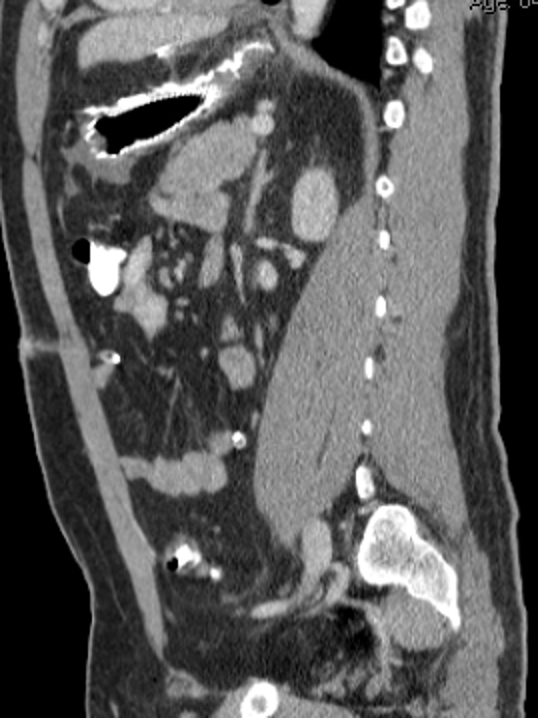Monday Poster Session
Category: Stomach and Spleen
P4213 - Refractory Chylous Ascites After Sleeve Gastrectomy
Monday, October 27, 2025
10:30 AM - 4:00 PM PDT
Location: Exhibit Hall

Kristina Franklin, DO (she/her/hers)
The Christ Hospital
Cincinnati, OH
Presenting Author(s)
Kristina Franklin, DO1, Urmimala Chaudhuri, DO2, Drew Triplett, DO3
1The Christ Hospital, Cincinnati, OH; 2Wright State University, Centerville, OH; 3Wright State University Boonshoft School of Medicine, Dayton, OH
Introduction: Chylous ascites is a rare postoperative complication characterized by the accumulation of triglyceride-rich lymphatic fluid in the peritoneal cavity. It presents with abdominal distension, discomfort, and nutritional deficiencies due to the loss of fats, proteins, and lymphocytes. While commonly associated with malignancy or trauma, it is exceedingly uncommon following bariatric procedures such as laparoscopic sleeve gastrectomy. Diagnosis is confirmed by paracentesis revealing milky fluid with triglyceride levels >200 mg/dL. Management ranges from conservative dietary and pharmacologic strategies to interventional radiology or surgery.
Case Description/
Methods: A 43-year-old male with morbid obesity underwent elective laparoscopic sleeve gastrectomy. Within 24 hours, he developed hemodynamic instability and underwent emergent laparotomy for intra-abdominal hemorrhage. Postoperatively, his Jackson-Pratt drain produced ~500 cc/day of milky fluid, initially raising concern for an anastomotic leak. CT imaging revealed a loculated fluid collection near the surgical site. Esophagogastroduodenoscopy showed no leak, but a 155 mm fully covered esophageal stent was placed prophylactically. Despite this, high-volume milky output persisted. Transferred to a tertiary center, drain fluid analysis revealed amylase of 184 U/L and triglycerides >2000 mg/dL, confirming chylous ascites. Total parenteral nutrition and subcutaneous octreotide were initiated, reducing output to < 200 cc/day. The stent was removed due to migration risk. Persistent milky drainage with elevated triglycerides indicated an ongoing lymphatic leak. The patient was discharged on a strict low-fat, medium-chain triglyceride diet and continued octreotide. Despite adherence, he returned with progressive abdominal distension. Paracentesis yielded >2 L of chylous fluid, necessitating repeated drainage. He is currently being evaluated for definitive intervention.
Discussion: This case highlights the diagnostic challenge of distinguishing chylous ascites from an anastomotic leak in the early postoperative period. Conservative management with dietary modification and octreotide initially reduced output, but persistent ascites required repeated paracentesis. Refractory chylous ascites may necessitate lymphangiography with embolization or surgical ligation. Early recognition and a multidisciplinary approach are essential for optimal outcomes.

Figure: Figure 1: Sagittal CT scan of the abdomen and pelvis in a patient post-sleeve gastrectomy, demonstrating refractory chylous ascites. The image reveals significant lymphatic fluid accumulation within the abdominal cavity, indicated by the areas of lower density (darker regions) in the anterior part of the abdomen, just below the diaphragm and above the intestines.
Disclosures:
Kristina Franklin indicated no relevant financial relationships.
Urmimala Chaudhuri indicated no relevant financial relationships.
Drew Triplett indicated no relevant financial relationships.
Kristina Franklin, DO1, Urmimala Chaudhuri, DO2, Drew Triplett, DO3. P4213 - Refractory Chylous Ascites After Sleeve Gastrectomy, ACG 2025 Annual Scientific Meeting Abstracts. Phoenix, AZ: American College of Gastroenterology.
1The Christ Hospital, Cincinnati, OH; 2Wright State University, Centerville, OH; 3Wright State University Boonshoft School of Medicine, Dayton, OH
Introduction: Chylous ascites is a rare postoperative complication characterized by the accumulation of triglyceride-rich lymphatic fluid in the peritoneal cavity. It presents with abdominal distension, discomfort, and nutritional deficiencies due to the loss of fats, proteins, and lymphocytes. While commonly associated with malignancy or trauma, it is exceedingly uncommon following bariatric procedures such as laparoscopic sleeve gastrectomy. Diagnosis is confirmed by paracentesis revealing milky fluid with triglyceride levels >200 mg/dL. Management ranges from conservative dietary and pharmacologic strategies to interventional radiology or surgery.
Case Description/
Methods: A 43-year-old male with morbid obesity underwent elective laparoscopic sleeve gastrectomy. Within 24 hours, he developed hemodynamic instability and underwent emergent laparotomy for intra-abdominal hemorrhage. Postoperatively, his Jackson-Pratt drain produced ~500 cc/day of milky fluid, initially raising concern for an anastomotic leak. CT imaging revealed a loculated fluid collection near the surgical site. Esophagogastroduodenoscopy showed no leak, but a 155 mm fully covered esophageal stent was placed prophylactically. Despite this, high-volume milky output persisted. Transferred to a tertiary center, drain fluid analysis revealed amylase of 184 U/L and triglycerides >2000 mg/dL, confirming chylous ascites. Total parenteral nutrition and subcutaneous octreotide were initiated, reducing output to < 200 cc/day. The stent was removed due to migration risk. Persistent milky drainage with elevated triglycerides indicated an ongoing lymphatic leak. The patient was discharged on a strict low-fat, medium-chain triglyceride diet and continued octreotide. Despite adherence, he returned with progressive abdominal distension. Paracentesis yielded >2 L of chylous fluid, necessitating repeated drainage. He is currently being evaluated for definitive intervention.
Discussion: This case highlights the diagnostic challenge of distinguishing chylous ascites from an anastomotic leak in the early postoperative period. Conservative management with dietary modification and octreotide initially reduced output, but persistent ascites required repeated paracentesis. Refractory chylous ascites may necessitate lymphangiography with embolization or surgical ligation. Early recognition and a multidisciplinary approach are essential for optimal outcomes.

Figure: Figure 1: Sagittal CT scan of the abdomen and pelvis in a patient post-sleeve gastrectomy, demonstrating refractory chylous ascites. The image reveals significant lymphatic fluid accumulation within the abdominal cavity, indicated by the areas of lower density (darker regions) in the anterior part of the abdomen, just below the diaphragm and above the intestines.
Disclosures:
Kristina Franklin indicated no relevant financial relationships.
Urmimala Chaudhuri indicated no relevant financial relationships.
Drew Triplett indicated no relevant financial relationships.
Kristina Franklin, DO1, Urmimala Chaudhuri, DO2, Drew Triplett, DO3. P4213 - Refractory Chylous Ascites After Sleeve Gastrectomy, ACG 2025 Annual Scientific Meeting Abstracts. Phoenix, AZ: American College of Gastroenterology.
